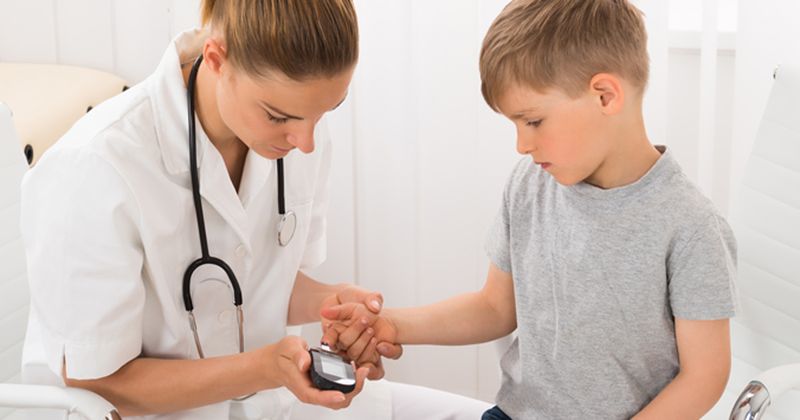Resiliency, flexibility crucial for caring for young children with type 1 diabetes
BALTIMORE — Providers should practice a patient-centered approach when caring for young children with type 1 diabetes and prepare tips for coping with unique challenges, according to two presenters.
Traci Carter, MA, RN, CDCES, a diabetes nurse educator for the Virgina Diabetes Council and Walter Reed National Military Medical Center, and Lt. Col. Noelle Larson, MD, FAAP, a pediatric endocrinologist at the Walter Reed National Military Medical Center, said providers face several when caring for young children with diabetes, including rapid physical growth, sensitivity to insulin, limited communication abilities, unpredictable eating and activity patterns, and more.

To tackle these challenges, the speakers urged providers to establish a solid foundation of diabetes resilience with the child’s care givers and to engage in a non-judgmental and constructive problem-solving approach when talking with individual patients.

“In young children, one of the main things I’m keeping in mind is the importance of flexibility in regimen,” Larson said during a presentation at the Association of Diabetes Care and Educational Specialists Annual Conference. “Typically, it’s also based on the availability of technologies and the position and mindset of families that just received the diagnosis.”
Importance of diabetes resiliency
The ADA 2022 Standards of Care include goals providers should aim for when caring for children living with type 1 diabetes. Children of all ages should aim for an HbA1c of less than 7% and avoid excessive hypoglycemia. Time in range should be maximized and complication risk mitigated.
One of the most important jobs for a provider is to guide care givers as they manage their child’s diabetes.
“It’s rarely the case that the difficulty of controlling blood sugar is a lack of knowledge on what blood sugar targets should be,” Larson said. “It’s more about how I go about [managing their child’s diabetes] while they go through a normal pathway of development, in order to achieve these goals.”
A few factors contribute to diabetes resiliency, including perceived self-efficacy, self-compassion and optimism. Larson said a growing body of literature shows that people with greater diabetes resiliency have lower HbA1c and better quality of life than those with less resilience. Additionally, she said, a child with diabetes will have greater diabetes resiliency in adulthood if their care givers are resilient while caring for them during childhood.
When a child is first diagnosed with diabetes, a typical regimen will consist of a long-acting basal or bolus insulin glargine. Larson said some children may also need small doses of short-acting prandial insulin. Insulin should be dosed immediately after eating to start, but parents should expect to start dosing insulin before meals by the time the child reaches age 6 years, Larson said.
Tips for caring for children with diabetes
Carter said strong communication with families can get them started on the right foot. After diagnosis, providers should conduct screening for autoimmune disorders, kidney disease, lipid screening and the presence of neuropathy in the feet. Annual nutrition assessments should be administered, and psychosocial screening should be conducted starting at age 7 or 8 years. All health information should be shared with care givers.
Children with diabetes should engage in daily physical activity, with 60 minutes of daily aerobics and moderate bone and muscle strengthening three times per week. Blood glucose monitoring should be increased during activity, with tighter continuous glucose monitoring alarms and decreases in pump basal insulin of 10% to 50% before, during and after activity, as needed. Care givers should limit screen time and inform trainers, teachers, coaches and school nurses about their child’s diabetes.

“If they are feeling excited to exercise, we may see their blood sugar go up before an activity and then come back down a little bit later,” Carter said. “I may be sharing with the families to watch for patterns at first and maybe allow for an extra snack.”
Care givers should collaborate with a dietitian to set up healthy carbohydrate ranges for each meal and snack. Carter advised providers to avoid carb shaming, however, saying it could set up disordered eating in the future. Families can try out premeasured snack bags for daycare or school, plan for school snacks, and keep no-carbohydrate snacks available at home.
Providers should prepare parents to make a 504 plan with their school system and to complete a diabetes medical management plan to submit to the school health staff. Providers should give feedback and evaluation regularly early in the diabetes diagnosis. When handing out educational assessments, Carter advised to consider language, culture and comfort level, and to present written materials on a fifth grade reading level. As a child ages,, providers should carefully assess whether they are ready to take on more of their own diabetes management.
“If the child is ready to try a task, it’s probably okay as long as they are supervised. I’m not going to discourage it,” Carter said. “However, I worry about when a child is expected to own it too soon.”
Providers should encourage diabetes education follow-up and prepare care givers for treating low and high blood glucose levels. Enabling a medical alert app on smartphones can keep care givers prepared in case of an emergency.
For CGM, care givers should consider connectivity and the ability to sleep through the night without being constantly interrupted by alarms. Body fat and skills should be considered for placing both CGM and insulin pumps. Providers should inform care givers that finger sticks can be used instead of CGM when necessary. Carter added that providers should empower care givers when insulin pump therapy is initiated in children.

